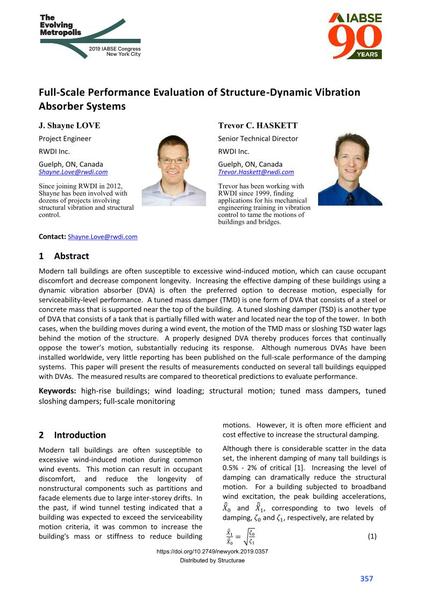Full-Scale Performance Evaluation of Structure-Dynamic Vibration Absorber Systems

|
|
|||||||||||
Bibliographic Details
| Author(s): |
Shayne Love
(RWDI Inc.)
Trevor C. Haskett (RWDI Inc.) |
||||
|---|---|---|---|---|---|
| Medium: | conference paper | ||||
| Language(s): | English | ||||
| Conference: | IABSE Congress: The Evolving Metropolis, New York, NY, USA, 4-6 September 2019 | ||||
| Published in: | The Evolving Metropolis | ||||
|
|||||
| Page(s): | 357-361 | ||||
| Total no. of pages: | 5 | ||||
| DOI: | 10.2749/newyork.2019.0357 | ||||
| Abstract: |
Modern tall buildings are often susceptible to excessive wind-induced motion, which can cause occupant discomfort and decrease component longevity. Increasing the effective damping of these buildings using a dynamic vibration absorber (DVA) is often the preferred option to decrease motion, especially for serviceability-level performance. A tuned mass damper (TMD) is one form of DVA that consists of a steel or concrete mass that is supported near the top of the building. A tuned sloshing damper (TSD) is another type of DVA that consists of a tank that is partially filled with water and located near the top of the tower. In both cases, when the building moves during a wind event, the motion of the TMD mass or sloshing TSD water lags behind the motion of the structure. A properly designed DVA thereby produces forces that continually oppose the tower’s motion, substantially reducing its response. Although numerous DVAs have been installed worldwide, very little reporting has been published on the full-scale performance of the damping systems. This paper will present the results of measurements conducted on several tall buildings equipped with DVAs. The measured results are compared to theoretical predictions to evaluate performance. |
||||
| Keywords: |
high-rise buildings wind loading tuned mass dampers structural motion tuned sloshing dampers full-scale monitoring
|
||||
